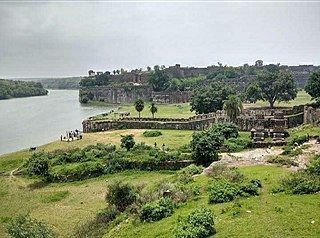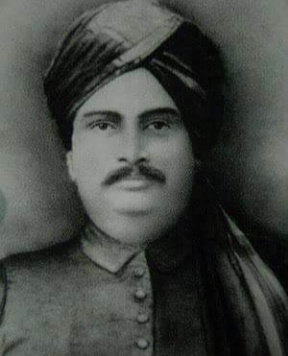Related Research Articles

Bhagalpur district is one of the thirty-eight districts of Bihar state, India. Bhagalpur is the oldest district of Bihar. Bhagalpur city is the administrative headquarters of this district.

Arshadul Qadri was a Sunni Islamic scholar, author and missionary activist in India associated with the Barelvi movement who established several educational institutions and organizations in India.

Madrasa Manzar-e-Islam, also known as Jamia Razvia Manzar-e-Islam, is an Islamic seminary in India. It was founded in 1904 in Bareilly, India by Ahmed Raza Khan Barelvi.

Badri Narain Sinha was born at village Saramohanpur in Darbhanga district of Bihar. An officer of Indian Police Service of 1952 batch of Bihar cadre of India, Sinha died in harness as Deputy Inspector General (CID), Government of Bihar. Sinha, described as ‘erudite and knowledgeable police chief’ by noted sociologist-journalist Arvind N Das, was a poet, critic, journalist, and a close associate of Jayprakash Narayan. Apart from the unique alchemy of brain and brawn that he displayed as an administrator and police officer, he was a thinker, littérateur, poet, a secular devout who broke bread with Muslims during the holy month of Ramzan as much as practicing austere Hindu fast during the whole month of Kartik, personifying in his life the multi-faceted moral actions that he highlights as Gandhi's character and, therefore, his message in his writings on the Mahatma.
Bindeshwari Prasad Sinha (1919-2002) was an Indian archaeologist and historian specialising in ancient Indian history. Sinha was a professor and head of the Department of History and Archaeology at Patna University. He was the founder of Bihar state's Directorate of Archaeology and Museums. He was also the director of the K. P. Jayaswal Research Institute in Patna.

Muhammad Akhtar Raza Khan Azhari, also known as Tajush Shari'ah or Azhari Miya, was an Indian Barelvi Muslim scholar, cleric and mufti. He was the great grandson of Ahmed Raza Khan Barelvi who was considered to be a Mujaddid by his followers and was the founder of the Barelvi movement. He was recognised by Barelvi Muslims as the Grand Mufti of India. He was ranked 22nd on the list of The 500 Most Influential Muslims in the world, compiled by the Royal Islamic Strategic Studies Centre. He had tens of millions of followers in India.
Syed Mohammed Izhar Ashraf was an Indian Sufi saint and Islamic scholar belonging to the Barelvi movement of Sunni Islam. He was the sajjadanasheen of Dargah of Ashraf Jahangir Semnani and Chief Patron the of All India Ulema and Mashaikh Board. He died on 22 February 2012 at age 78 while receiving treatment at the Ismailia Hospital.
Batohiya is a Bhojpuri poem written by Raghuveer Narayan in 1911. This Purbi song became very popular and George Abraham Grierson also recorded this song for Linguistic Survey of India in 1920. It has also been called the "Vande Matram" of Bhojpuri. The poem was first published in Raghuveer Patra Pushp.
Malladeva was the son of King Nanyadeva from the Karnat dynasty, and a prince of Mithila. According to some scholars, Malladeva has been referred to as the "forgotten King of Mithila" as most records and traditions mention that his brother Gangadeva succeeded his father as ruler of the dynasty. Nevertheless, Malladeva seems to have founded his own stronghold in the village of Bheet-Bhagwanpur in Darbhanga in modern-day Bihar, India. In the village, an inscription was found which read "Om Shree Malladevasya" and many Karnat-era sculptures have been found in the area.

Shergarh Fort is a ruined fort in Malhipur, Chenari block of Sasaram, it is well connected from Kudra and as well from Sasaram, Bihar. It is a hill fort on a Kaimur plateau about 800 feet in height and was fortified by Emperor Sher Shah Suri. The fort is in dense forest, making access difficult from the bottom of the plateau. The fort lies on the banks of the Durgavati River.
Bindiya is a social novel by Bhojpuri author Ramnath Pandey. It is the first novel written in Bhojpuri. It was published in 1956 by Sekhar Publication of Chhapra. Thematically, it is based on life and problems of the village lifestyle. The story is set in a village of a common farmer Kodai his daughter Bindiya and her lover Mangra

The Murho Estate was a Chieftaincy and later a Zamindari (estate) of Yadav (Ahir) in erstwhile Bhagalpur district of Bihar.
Phool Bahadur is a novel in Magahi language by Indian author Jainath Pati that was published in 1928 and was the first novel written in Magahi Language. It was a Comic novel and was published on first of April on April Fools' Day.
Rathore is a Rajput clan. Some historians link their origin to the Rashtrakuta dynasty.
Makhdoom Syed Shah Shahbaz Muhammad Dev poori Bhagalpuri (1549-1630) known as Shahbaz Mohammad Bhagalpuri was an Indian Islamic scholar and Sufi saint during the ruling era of Mughal Emperor Jahangir.
Madrasa-e-Aliya, also known as Government Oriental College, is an Islamic educational seminary situated in Rampur, Uttar Pradesh. It was established in 1774 by Nawab Faizullah Khan of Rampur State.
Momin Arif was an Indian Sufi saint. He is known as the first Muslim to reach Bihar in 11th Century. He was accompanied by Imam Muhammad Taj Faqih, the grand father of Makhdoom Yahya Maneri who belonged to Jerusalem. He arrived Maner, Bihar for business purpose but later engaged in preaching Islam.
Imam Muhammad Taj Faqih Hashmi also spelled Taj Faqeeh was an Islamic scholar, Warrior and Sufi saint who came India to preach Islam after Momin Arif reached India, and he dreamed about India and came to help Arif in propagating Islam and fight against the King of Maner. He reached India in 1180, and led a war against the King of Maner, a neighbourhood in Patna district of Bihar.

Firdausiyya is a Sufi Order which originated as a off-shoot from the Suhrawardiyya order. It was introduced by Shaikh Badruddin Samarqandi in India, and later took forward by two of his disciples, Najibuddin Firdausi and Ruknuddin Firdausi. It was mostly known and flourished during the life of Shaikh Sharfuddin Ahmed Yahya Maneri, buried in Badi Dargah, Bihar Sharif. He had the longest chain of spiritual successors in the Magadh region of Bihar. The ideology of the Suhrawardiyya was inspired by Sayf al Din Bakharzi, and also took its name from Bakharzi, who was given the title of Shaikh al-Firdaus by his spiritual master Najmuddin Qubra. Firdausiyya Order was established even before the Chishty order.
References
- ↑ "भागलपुर : मदरसा जामिया शहबाजिया में इस्लामी शिक्षा के साथ कंप्यूटर, हिंदी, अंग्रेजी और गणित पढ़ना होगा अनिवार्य". Dainik Jagran (in Hindi). Retrieved 2023-12-24.
- ↑ admin (2021-08-17). "Khanqah-e-Shahbazia, Bhagalpur". Muslims Of India. Retrieved 2023-12-24.
- ↑ Sinha, Bindeshwari Prasad (1987). Comprehensive History of Bihar. Kashi Prasad Jayaswal Research Institute.
- ↑ Chatterjee, Kumkum (1996). Merchants, Politics, and Society in Early Modern India: Bihar, 1733-1820. BRILL. ISBN 978-90-04-10303-0.
- ↑ Sinha, Bindeshwari Prasad (1976). Comprehensive History of Bihar: pt. 2 [1976]. Kashi Prasad Jayaswal Research Institute.
- ↑ Bihar (India); Choudhury, Pranab Chandra Roy (1962). Bihar District Gazetteers: Hazaribagh. Superintendant, Secretariat Press, Bihar.
- ↑ "ख़ानक़ाह शाहबाज़िया मस्जिद और मदरसा". hindi.livehistoryindia.com. Retrieved 2023-12-24.
- ↑ Narain, V. A. (1970). "The Bhagalpur Madarsa". Proceedings of the Indian History Congress. 32: 173–176. ISSN 2249-1937. JSTOR 44138522.
- ↑ Commission, Indian Historical Records (1958). Proceedings of the ... Session. The Commission.
- ↑ "List of MCPC-s | National Mission for Manuscripts |". www.namami.gov.in. Retrieved 2023-12-24.